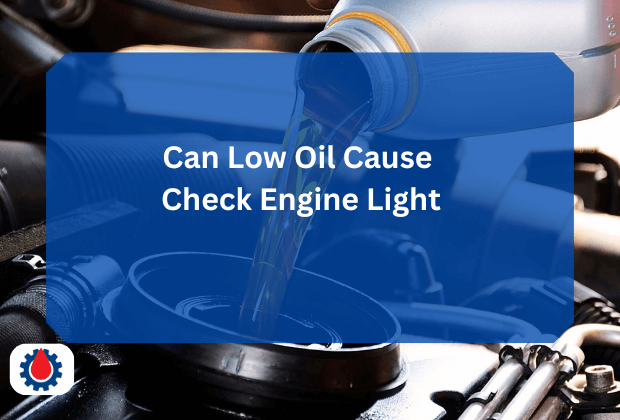In this post, we’ll explore how low oil can lead to a check engine light, why it happens, and what you should do if you encounter this issue.
Can Low Oil Cause Check Engine Light
Yes, low oil can cause the check engine light to come on. Low oil levels or poor oil quality can lead to issues like low oil pressure, engine misfires, or problems with variable valve timing systems, which are detected by the vehicle’s onboard diagnostics system (OBD-II).
For instance, insufficient oil can trigger diagnostic trouble codes such as P0521 (oil pressure issues) or P0300 (misfires), illuminating the check engine light. Other symptoms, like engine noise or overheating, may also occur. To address this, check the oil level, top it off if needed, and scan for codes.
Related Check Engine Light After Oil Change(8 Causes & Fixes)
How Low Oil Triggers the Check Engine Light
Engine oil lubricates moving parts, reduces friction, dissipates heat, and prevents wear and tear in your engine. When oil levels drop too low or the oil becomes degraded, several problems can arise, potentially causing the check engine light to activate. Here’s how:
1. Low Oil Pressure
Most modern vehicles are equipped with an oil pressure sensor that monitors the pressure of oil circulating through the engine. If the oil level is too low, the oil pump may struggle to maintain adequate pressure, triggering a low oil pressure warning.
In some cases, this can also cause the check engine light to come on, as low oil pressure can lead to engine damage or misfires. For example, a DTC like P0521 (Engine Oil Pressure Sensor/Switch Range/Performance) may be logged.
2. Engine Misfires
Low oil levels can cause insufficient lubrication, leading to increased friction and heat in the engine. This can result in engine misfires, where one or more cylinders fail to combust fuel properly. Misfires are often detected by the OBD-II system, which may trigger codes like P0300 (Random/Multiple Cylinder Misfire Detected) and illuminate the check engine light.
Related Overfilled Engine Oil by 1 Litre(5 Things To Do)
3. Variable Valve Timing (VVT) Issues
Many modern engines use variable valve timing systems to optimize performance and fuel efficiency. These systems rely on proper oil pressure to function correctly.
Low oil levels or degraded oil can disrupt VVT operation, causing the engine control unit (ECU) to detect a fault and trigger codes like P0011 (Camshaft Position Timing Over-Advanced) or similar, resulting in a check engine light.
4. Oil Contamination or Sludge
If the oil is old, contaminated, or has turned into sludge due to neglected maintenance, it may not lubricate the engine effectively. This can cause various engine components to malfunction, leading to performance issues that the OBD-II system detects. For instance, sludge buildup can clog oil passages, reducing oil flow and triggering the check engine light.
Related Water in the Oil of the Engine(4 Causes + Solutions)
5. Secondary Effects
Low oil can cause overheating or excessive wear on engine components, such as bearings or the camshaft. These issues can lead to additional problems, like poor fuel economy or emissions failures, which the OBD-II system may flag with a check engine light.
Symptoms of Low Oil Beyond the Check Engine Light
In addition to the check engine light, low oil levels or poor oil quality may cause other symptoms, including:
- Engine noise: Knocking, ticking, or grinding sounds due to inadequate lubrication.
- Reduced performance: Sluggish acceleration or loss of power.
- Overheating: Oil helps dissipate heat, so low levels can cause the engine to run hotter.
- Oil warning light: Many vehicles have a separate oil pressure or low oil warning light that may accompany the check engine light.
Related Low Engine Oil Pressure(8 Common Causes & Solutions)
What to Do If Low Oil Triggers the Check Engine Light
If you suspect low oil is causing your check engine light, take the following steps to address the issue promptly and avoid costly repairs:
1. Check the Oil Level
Park your car on level ground, let the engine cool, and check the oil level using the dipstick. If it’s below the “low” mark, add the recommended oil type for your vehicle. Refer to your owner’s manual for the correct oil viscosity (e.g., 5W-30) and specifications.
2. Inspect for Leaks
Look under the vehicle for signs of oil leaks, such as puddles or stains. Common leak points include the oil pan, valve cover gasket, or oil filter. If you find a leak, have it repaired by a professional.
3. Scan for Diagnostic Trouble Codes
Use an OBD-II scanner (available at auto parts stores or repair shops) to read the trouble codes. This will help pinpoint whether the issue is related to oil pressure, misfires, or another problem.
Related Engine Oil Leak – 7 Alarming Signs(How to Fix Them)
4. Change the Oil if Needed
If the oil is low, dirty, or overdue for a change, perform an oil change. Use high-quality oil and a new filter to ensure proper engine lubrication.
5. Consult a Mechanic
If the check engine light persists after topping off the oil or if you notice other symptoms, take your vehicle to a trusted mechanic. They can diagnose underlying issues, such as a failing oil pump, clogged oil passages, or damaged engine components.
Preventing Low Oil Issues
To avoid low oil-related problems and keep your check engine light off, follow these maintenance tips:
- Regular Oil Changes: Stick to your vehicle’s recommended oil change intervals (typically every 5,000–7,500 miles or as specified in your owner’s manual).
- Monitor Oil Levels: Check your oil level monthly to catch leaks or consumption issues early.
- Use the Right Oil: Always use the manufacturer-recommended oil type and viscosity.
- Address Warning Signs: Don’t ignore unusual engine noises, performance issues, or warning lights.
Related How to Fix an Oil Leak Between Engine and Transmission(In 5 Steps)
Final words
Low oil can indeed cause the check engine light to come on, often due to low oil pressure, engine misfires, or issues with systems like variable valve timing. If your check engine light is on, don’t ignore it, check your oil, scan for codes, and seek professional help if needed to keep your car in top shape.




